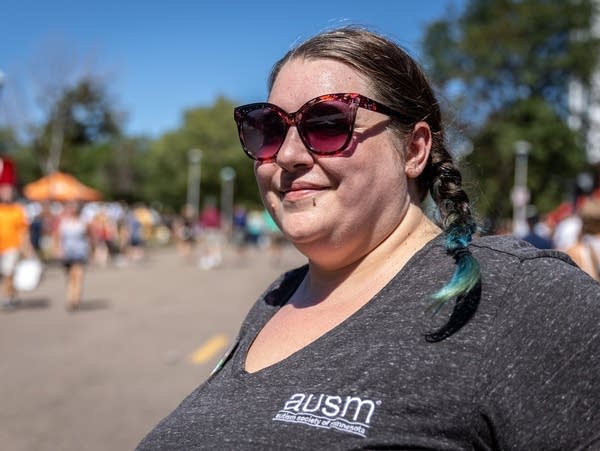Making a more accessible fair experience
The Autism Society of Minnesota gives us a tour of the fair through an autistic lens

Go Deeper.
Create an account or log in to save stories.
Like this?
Thanks for liking this story! We have added it to a list of your favorite stories.
On Wednesday Jillian Nelson and Ellie Wilson of the Autism Society of Minnesota met MPR News’ digital producer Sam Stroozas and photojournalist Ben Hovland at the MPR booth at the Minnesota State Fair. The plan was simple — set out to record a video from the point of a view of an autistic person at the fair.
Nelson, who is autistic herself, led the tour. We began near the haunted house, where Nelson says is one of the loudest corners and the most anxiety-inducing for her.
“Typically at this intersection it’s bumper to bumper, you can’t move. You have a lot of visual stuff coming off the haunted house and people coming into the fair,” she said.
Nelson doesn’t travel anywhere without her essentials: noise-reducing headphones, fidget toys water (usually from her favorite water bottle) and other sensory tools. At the fair, and in most places, she says she needs to know where her exit is, or a place she can be when she gets too overwhelmed.
Turn Up Your Support
MPR News helps you turn down the noise and build shared understanding. Turn up your support for this public resource and keep trusted journalism accessible to all.
Depending where she is on the Fairgrounds, she may go to the Lee & Rose Warner Coliseum and watch a horse show or check out the Agriculture Horticulrure building.
“I have learned so many random facts simply because I end up in random places to escape,” Nelson said.
It’s difficult to make any place completely sensory friendly Wilson said, the executive director of the Autism Society of Minnesota. Nelson explained that Wilson is “one of her people,” a person that knows how to work with her and calm her down during overly stimulating moments.
“We have to figure out how to create places within the overall scene for people. We aren’t trying to put people in bubbles or make the perfect experience; it’s about having access to what you need when you need it,” Wilson said.
But the difference between Nelson’s brain and one without autism — she can’t filter these sounds out. And she says because she doesn’t “look disabled,” others may react poorly to her. She said typically autistic people are seen as young, white boys but when it shows up in older people, women, or people of color — they may not be treated with the same respect or options.
“There’s a perception of what I need to look like as a disabled person and some days it’s just really coming prepared and knowing what you need to survive anything and others … it’s just surviving,” she said.
Nelson says she will have a “completely autistic” experience at the fair, and she’s okay with that. She wouldn’t want it any other way.
“I am going to over plan, I am going to know where all the quiet places are, I am going to come with a team of people and have a bad of fidgets and an exist strategy if things go sour.”
And sometimes they do go sour. Nelson described it like having a computer open with 67 tabs and none of them will close. She’s more in tune than others. While standing for an interview she explained she heard the band, three sets of stroller wheels, dozens of conversations, shoes scuffing, a set of keys jingling and more.
Jillian Nelson’s Top Five Tips for Autistically Mastering the Minnesota State Fair:
Prep before you visit. Find a map of the fair, know your exits and where you can go to calm down.
Remember to pack helpful items. What do you need, what will help you be most at ease?
Find your allies. Bring friends with and people you trust that can work with you.
Remember to take a break when you need it. Check out the Fraser Sensory building or other places to relax.
Eat all the yummy food! Don’t forget to enjoy yourself.


